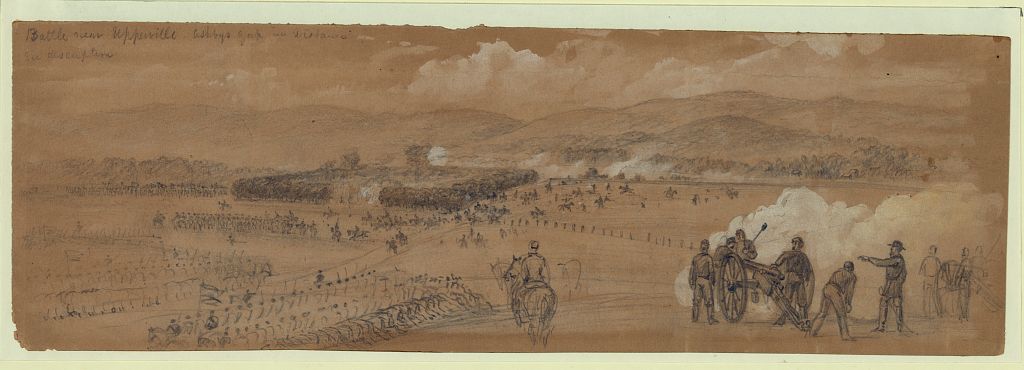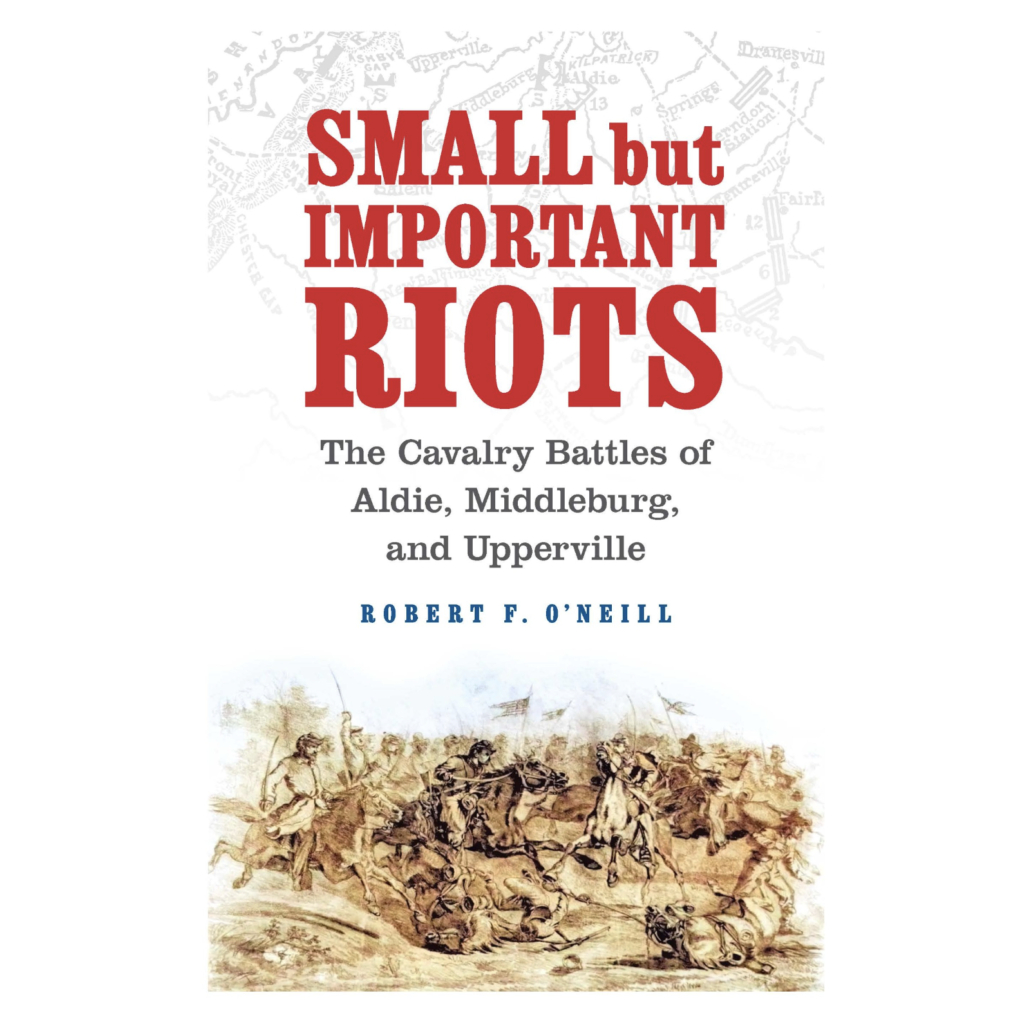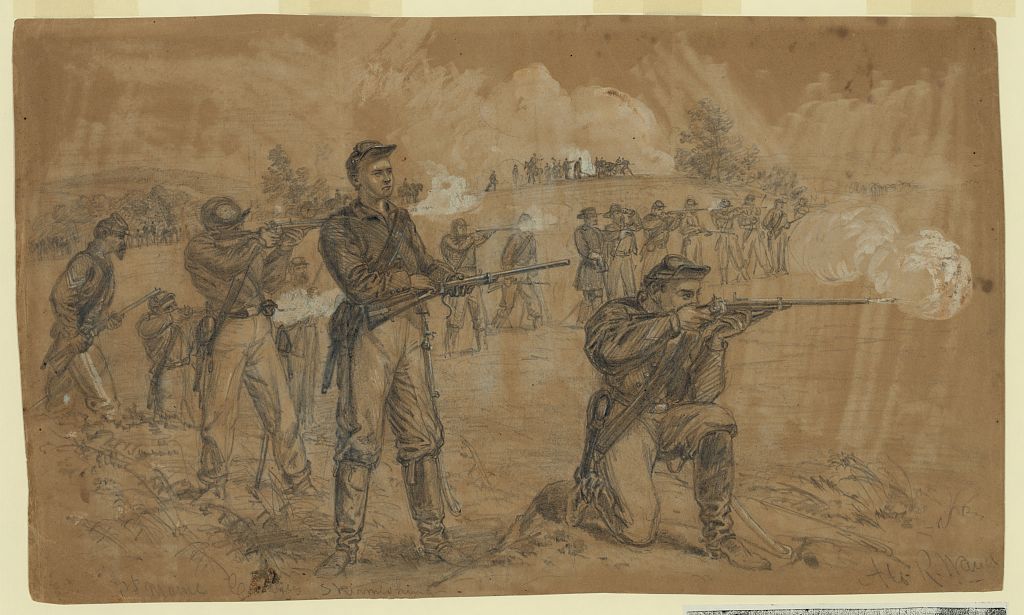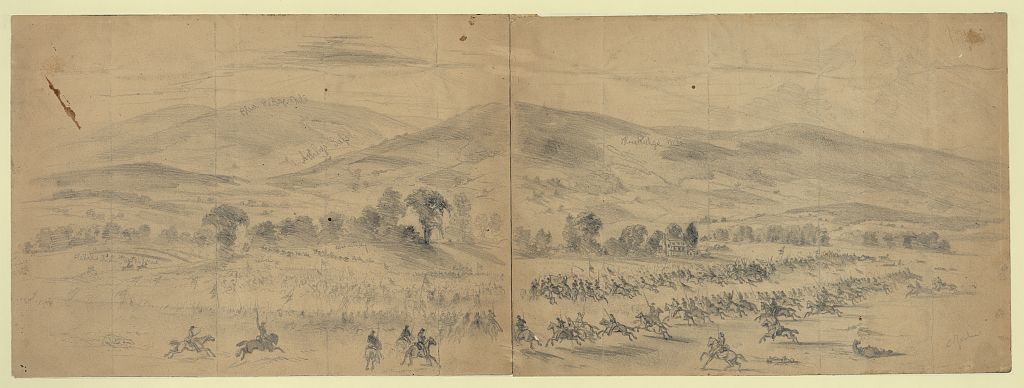Local History: Robert F. O’Neill’s “Small but Important Riots”

Written by Heidi Baumstark
Everyone knows that horses take center stage in Virginia’s Hunt Country.
But not everyone knows about another “stage” our four-legged friends premiered in during the summer of 1863: war.
In “Small but Important Riots: The Cavalry Battles of Aldie, Middleburg, and Upperville,” author Robert F. O’Neill unpacks the details of three cavalry battles in Loudoun County that were part of the Gettysburg Campaign. These battles broke out along an approximate 12-mile stretch of Ashby’s Gap Turnpike (today’s John Mosby Highway) when mounted soldiers clashed in summer 1863 — Aldie (June 17), Middleburg (June 19), and Upperville (June 21).
All three conflicts resulted in Union victories, but Confederate general J.E.B. Stuart maintained an upper hand, sparring with Union commander Alfred Pleasonton as a delay tactic to prevent him from gaining intelligence on Robert E. Lee’s movements. By preventing Federal forces from passing through local mountain gaps, Stuart’s cavalry allowed Lee’s troops to travel north unhindered.
After all, it’s the cavalry (horse-mounted soldiers) who are the most mobile operating in roles of reconnaissance, screening, and skirmishing. “Cavalry protects the infantry,” explains O’Neill. “That’s one of their jobs. The other is to find the enemy.”
These three clashes took place between the famous battles of Brandy Station in Culpeper County, June 9, 1863 (the largest predominantly cavalry engagement of the entire Civil War, resulting in a Confederate victory), and Gettysburg, July 1–3, 1863, a win for the North. O’Neill points out, “These three cavalry battles were overshadowed by Gettysburg, [which] happened just 10 days later.”


About O’Neill
O’Neill lives in Virginia’s Northern Neck and comes from a distinguished career in law enforcement. His parents instilled a strong interest in reading and history, which led to his study of the Civil War, specifically the Union cavalry in the crucial year of 1863. On his mother’s side, O’Neill has two ancestors who fought in the war.
O’Neill’s original edition of “Small but Important Riots” was released in 1993, but after gaining access to previously unpublished documents, O’Neill published a second edition in 2023 with an updated narrative and added information from recently discovered letters, diaries, and soldier records. “I think I cited 13 newspapers in the 1993 edition, but with today’s access to digital databases changing the way research is done, I cited 89 newspapers in this 2023 edition,” he says. After 30 years of searching the National Archives for records pertaining to the Civil War, O’Neill’s findings have significantly advanced the understanding of these three cavalry battles.
The origin of O’Neill’s book title comes from U.S. Infantry Captain John W. Ames, who was in the area on June 21, 1863. From Aldie, he heard cavalry fighting around Upperville (about 12 miles west of Aldie), and listened to the battle throughout the day, later explaining that the cavalry was fighting “small but important riots.”
“Though Ames is away from the firing,” O’Neill says, “they heard cannon and found out it was the cavalry fighting…. There were a series of skirmishes during that day [June 21, 1863] that surrounded Upperville itself; Goose Creek Bridge is one of those areas.”
The Three Cavalry Battles
According to published records, Pleasonton’s superiors — President Lincoln, U.S. Secretary of War Edwin Stanton, and army commander Joseph Hooker — ordered Pleasonton to search for Lee’s Army of Northern Virginia who was heading into the Shenandoah Valley, north toward the Potomac River, and into Pennsylvania. “Hooker’s objective was to save Washington — the capital — from attack,” O’Neill explains. “Hooker was to send his cavalry out to look for Lee. But, Pleasanton disobeyed Hooker’s orders; I found documents that prove this.”
As cavalry commander, Stuart had the whole width of the Loudoun Valley to keep Federal forces away from Lee. Pleasanton was not to take his cavalry into the Loudoun Valley, but he did. And when Pleasonton and Stuart run into each other, that’s what leads to these three cavalry battles in June 1863.

Stuart was in the little mill village of Aldie when fighting broke out on Wednesday, June 17, at a sharp curve on Snickersville Turnpike. A stone monument commemorating the 1st Massachusetts Cavalry stands nearby, honoring those who fought at the Battle of Aldie. “It was erected by survivors of the 1st Massachusetts Cavalry; they suffered many heavy losses there,” O’Neill says.
An aspect of the Battle of Middleburg that has always been a mystery was its exact location. On June 17, French-American Union soldier Alfred Napoléon Duffié led his regiment into the Loudoun Valley, where they would ultimately perish. Having found a letter referring to the death of one of Duffié’s officers, O’Neill’s book at long last reveals the circumstances of their defeat. “Based on the information in that letter and further research, I was able to pinpoint where that battle was fought,” he explains. “Duffié, coming into Middleburg on the night of the 17th, was attacked, driven out of town, and retreated south. On the morning of the 18th he’s attacked again; that’s when his officer was killed. Duffié was coming into Middleburg via The Plains Road.”
Severe fighting broke out about one mile west of the village of Middleburg, near a cluster of 19th-century stone buildings still standing at what is now Mt. Defiance Historic Park. On Friday, June 19, the Battle of Middleburg enveloped the area around the blacksmith shop at the intersection of the old Zulla roadbed and John Mosby Highway. The Union’s 1st Maine Cavalry were fighting dismounted from their horses, and the outnumbered Confederates were almost overrun. A stone monument dedicated to the bravery of the 1st Maine Cavalry stands on the grounds of Mt. Defiance, and in the old Zulla roadbed stands a 12-pound Napoleon howitzer cannon that Confederates used as a defensive position.

Stacked stone walls, still visible today, bordering Mt. Defiance provided cover for Union and Confederate soldiers along both sides of the old turnpike. In the evening of June 19, a storm rolled in, ending the Battle of Middleburg, which resulted in about 400 casualties. Churches became hospitals, including Aldie’s Mt. Zion Church, where graffiti by soldiers can still be seen on the walls.
The Battle of Upperville occurred on the afternoon of Sunday, June 21, ending five days of cavalry engagements along Ashby’s Gap Turnpike including the area of the Goose Creek Bridge, which spans the waters of Goose Creek in four arches. Northern and Southern cavalry brigades totaling about 6,000 men with horse artillery clashed that afternoon in Upperville across the Ayrshire and Kirkby farms, between Trappe and Greengarden roads.
“That fight has been interpreted several different ways over the years,” O’Neill adds. “The owner of Kirkby Farm allowed me to walk the property and I was able to sort out that battle, as well.” Kirkby Farm was also the site of the Battle of Unison, which occurred months earlier, November 1–3, 1862. The farm is now permanently protected by a conservation easement with the Old Dominion Land Conservancy located in Purcellville.

By the night of June 21, almost a week’s worth of fighting resulted in fatigued and injured mounts, dwindling supplies, and high casualties on both sides. Just 10 days later, the Battle of Gettysburg (July 1–3, 1863) would break out.
160 Years Later
In commemoration of the 160th anniversary of these three cavalry battles, NOVA Parks is teaming up with the Virginia Piedmont Heritage Area to provide a weekend program June 17 to 18. The weekend will include a family-friendly living history program at Mt. Zion Church in Aldie and guided tours at Mt. Defiance, and an all-day bus tour on June 17 will be led by VPHA Historian Emeritus Rich Gillespie.
On June 18, O’Neill will present a talk on his second edition of “Small but Important Riots” at Buchanan Hall in Upperville. The event concludes with a book signing and a beer and wine reception.
NOVA Parks Site Manager Tracy Gillespie, who invited O’Neill to speak, adds, “Bob’s book is extraordinary. He has shared a lifetime of learning through this narrative, which has been described as a ‘tactical study’ of the cavalry battles, but it’s so much more than that. It’s storytelling at its best!”
“Thirty years ago, there was no parkland there; it was all private property,” O’Neill points out. “But now we have Mt. Defiance Park and lots of other land placed in easements by folks who live out there.”
Reflecting on his research, O’Neill concludes, “Years ago, I met the late John Divine,” a nationally recognized authority on the Civil War and a native of the early 18th-century village of Waterford in Loudoun. “In 1980, John took me to the Route 50 corridor and explained what he understood about those battles. He suggested I try to write a book on it. I had never set out to do that, but one thing led to another. And I did. I hope that in 10 years someone else will take the story even further.”
Thanks to O’Neill and his dedication to research, we can learn more about these important cavalry battles and their role in the Civil War. And thanks to dedicated preservation efforts by NOVA Parks and other organizations, we can witness the fields and drive the roads where cavalrymen — and their proven steeds — changed history.
More information about the June 17 bus tour (10 a.m. to 5 p.m.) beginning at Mt. Zion Historic Park (40309 John Mosby Highway, Aldie, Virginia) and the June 18 (2 to 4 p.m.) lecture by O’Neill at Buchanan Hall in Upperville can be found at VPHA’s website at piedmontheritage.org. Information on O’Neill’s book and his other publications and articles in historical magazines can be found at smallbutimportantriots.com. ML
Published in the May 2023 issue of Middleburg Life.








